|
|
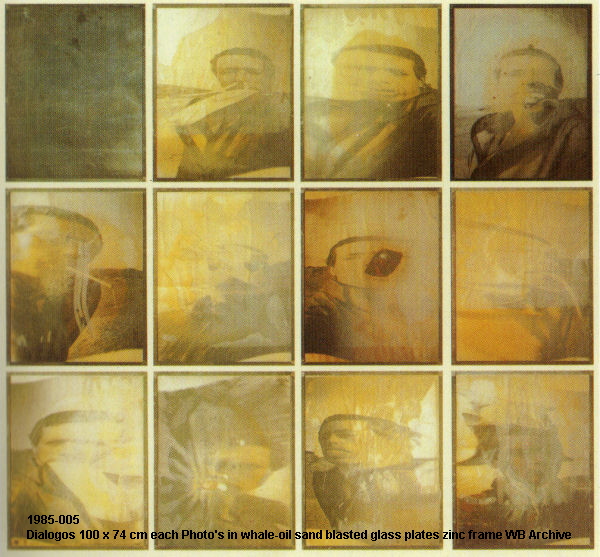 Tierra del Fuego, drawings with Neolithic Carbon on coffee soaked paper, 10.5x16.5cm Tierra del Fuego, drawings with Neolithic Carbon on coffee soaked paper, 10.5x16.5cm
In the late autumn of 1984, Bien leaves for Tierra del Fuego in Chile and Argentina: from there he is invited to participate in an archaeological expedition to Bahia Valentin at Peninsula Mitre. By that time, the inhabitants of Tierra del Fuego have become extinct. That what is left of the nomadic people is the camps, and especially the remainders of fires and the trash heaps consisting of artifacts, leftovers and skeletons of animals. And apart from that: a rough scenery with perennially green beech woods, and an ever set wind which forces everything in the same direction and which fills the silent desolation with a persistent whistling.
During his three month stay in Tierra del Fuego, Waldo Bien creates a series of drawings that can be read like a travel account: sceneries (sometimes a rudimentary indication, sometimes in detail), but also animals and their skeletons, campfires, trash heaps, colonists’ houses, etc.
The drawings are made with Neolithic charcoal, i.e., the remnants of charcoal that Bien finds in the trash heaps and the remainders of the campfires - the last signs of life of the extinct nomadic people.
He also makes a series of photographic self-portraits, in which we see Bien with a kind of masks, for which he uses bones of animals which he finds in the trash heaps, too, and to which he assigns a (new) meaning.
He has discussions about this subject with Hernan Vidal the leading archeologist of the expedition, for whom the bones are merely meaningless garbage. Back in his studio, Bien enlarges the pictures and prints them in such away that deformations come into being that make it seem as if, here, too, the wind has forced everything to one side. The pictures are, moreover, treated with whale blubber—an explicit reference to the Indians of Tierra del Fuego, whose social ties manifested themselves in the whale hunt: the wandering nomads, who normally lived in small family structures, combined forces in order to hunt this giant sea animal.
In the quiet desolation of the Cape Horn Archipelago, the wind is undoubtedly the most emphatic presence. Not only as a directive movement, but also as the only force that continuously breaks the silence.
The wind makes the silence and the desolation emphatically perceptible, but at the same time it makes them bearable. Múmö Skúla 1985-004: Back home again, in the silence of Bien’s studio this wind comes alive again: 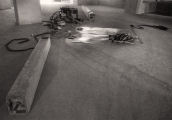 a pair of bellows, driven by an electric motor, forces its energy, like a lung, into three flutes which, at regular intervals, fill the room with the soft, but by no means less emphatic presence of their plaintive voice. The tone frequencies have been determined by the frequency analysis of Tierra del Fuego’s scenery (flora, fauna and tierra). The reed pipes of the instrumental parts have been made of basalt from the Isle Navarino (tierra), nothofagus antarctica (flora) and whale bone (fauna). The flutes’ sizes are 5.2x0.245x0.32 m (tierra), 2.70x0.215x0.25 m (flora) and 0455x0.3x0.03 m (fauna). a pair of bellows, driven by an electric motor, forces its energy, like a lung, into three flutes which, at regular intervals, fill the room with the soft, but by no means less emphatic presence of their plaintive voice. The tone frequencies have been determined by the frequency analysis of Tierra del Fuego’s scenery (flora, fauna and tierra). The reed pipes of the instrumental parts have been made of basalt from the Isle Navarino (tierra), nothofagus antarctica (flora) and whale bone (fauna). The flutes’ sizes are 5.2x0.245x0.32 m (tierra), 2.70x0.215x0.25 m (flora) and 0455x0.3x0.03 m (fauna).
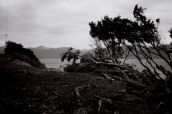 Bien’s Tierra del Fuego’ can be considered a monument for cultures that disapear in the change of time. Of which only the rudimentary signs remain - signs, the significance of which we are hardly or not able to understand. ‘Tierra del Fuego’ is also a critical comment, fed by individual experiences and observations and imbued with a deep-seated consciousness. It brings the western positivist scientific mentality of the nature and the qualitative values of (lost) cultures up for discussion. Bien’s Tierra del Fuego’ can be considered a monument for cultures that disapear in the change of time. Of which only the rudimentary signs remain - signs, the significance of which we are hardly or not able to understand. ‘Tierra del Fuego’ is also a critical comment, fed by individual experiences and observations and imbued with a deep-seated consciousness. It brings the western positivist scientific mentality of the nature and the qualitative values of (lost) cultures up for discussion.
After all, within the scientific approach of our world and life, there is hardly any place for qualities that can be understood and experienced intuitionally, merely for quantities.
As a consequence, we disregard the quality of our own existence and put the future at stake. For, if we are blind to that quality - of the past as well as of the present -, we are unable to draw, from that past 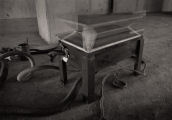 and present, the strength and the energy with which we can give the future its own purport and its own quality. In his ‘Tierra del Fuego’, Bien has set off figuratively, not literally, for the long journey to a different culture. and present, the strength and the energy with which we can give the future its own purport and its own quality. In his ‘Tierra del Fuego’, Bien has set off figuratively, not literally, for the long journey to a different culture.
The purpose of that journey was not to collect, to observe or to document the externals of that culture, but an attempt to deepen and to fulfill, anthropologically, the own culture through experience.
In 1983 Waldo Bien gives the Indians of Tierra del Fuego their final resting-place : In a lava tunnel on Iceland he equips their final encampment: Frozen Fire. During a visit, summer 1985, the ice in the lava cave was found melted. The photo’s where taken home to Amsterdam and framed > 1997-027
October 24th, 1987
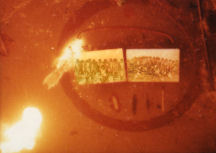 Frits Bless Frits Bless
(1) The Indians of Tierra del Fuego could be distinguished into three tribes:
- Selk’nam (Ona) — Isla Grande (land nomads)
- Yamana (Jahgan) -Cape Horn Archipelago
- Halakwulup (Alakuluf) - West Patagonian isles
(2) In 1984, a few months before Bien’s arrival, the last native of Tierra del Fuego dies in a Port Williams mission.
|
|
|
|
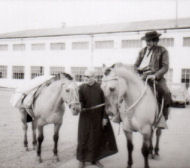 Rio Grande, by Waldo Bien (Translation Follows in Updatings) Rio Grande, by Waldo Bien (Translation Follows in Updatings)
Drie mijl van de plaats war de Rio Grande uitmondt in de oceaan ligt de hacienda van de paters Saliciano’s.
Op de bruingrijze kleivelden voor de kust, welke vroegere lopen van de rivier aangeven, staan enige slordige betonnen huisjes, de casas blankas, waarin het personeel van de technische school en de erbij behorende estancia zijn ondergebracht.
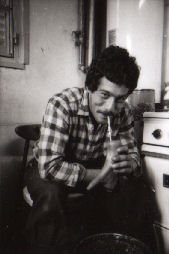 Het ruime missiegebouw biedt uitzicht op de kust en in de rug wordt het gedekt door een parallel verlopende vijfentwintig meter hoge bodemverschuiving in de landschap. Onmiddellijk daarachter ligt de glooiende pampa van Isles Grandes noorden. Het ruime missiegebouw biedt uitzicht op de kust en in de rug wordt het gedekt door een parallel verlopende vijfentwintig meter hoge bodemverschuiving in de landschap. Onmiddellijk daarachter ligt de glooiende pampa van Isles Grandes noorden.
Twee jaar had Ricardo er voor de padres als gaucho gewerkt en door zijn prachtige gelaat en troste houding iets aristocratisch verleend aan de troosteloze omgeving. ledereen bewonderde hem als hij met zijn paard over de vlakte reed.
Over enige dagen zou zijn contract hier afgelopen zijn en volgens afspraak zou hij twee prachtige paarden uit de kudde krijgen en hij zou er mee naar Buenos Aires rijden omdat nog niemand dat gedaan had en el Presidente hem ontvangen zou en alle vrouwen van hem houden en hij zou doen alsof het niets was.
Hij deelde het schamele huis met de missiekok, een wrak van een lichaam en aiweer een schroothoop van een kok en zo waren de magen van ijzer geworden.
Van de kleine kreupele Juan die ook in het huis woonde werd gezegd dat hij de koning der Gauchos was. Hij werd geboren met een kreupel been en had als opgroeiende jongen, toen het been ook psychisch pijn ging doen, de sprong op het paard gewaagd en er was geen ruiter zoals hij.
Zijn half Indiaanse gezicht was zachtaardig en in zijn ogen brandde een warme gloed. Enkele jaren geleden hadden de Padres zijn dagelijks leven verzacht door hem de zorg over het kleine missiemuseum toe te vertrouwen, de casa de indiginos geheten, waar de laatste Onas (of Selknam zoals zij zichzelf noemden) hun laatste jaren sleten met borduurwerk en het schrijven van moeilijke en betekenisloze woorden.
Zijn paard hadden de Padres daarbij menslievend verruild voor een gammel Renault 4-tje waarin de onttroonde koning der Gauchos nu voorzichtig sporen trok door het dorre gras.
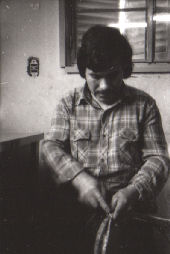 Juan en Ricardo hadden een merkwaardige vriendschap. Juan had er zijn leven voor willen geven om even het volmaakte lichaam te mogen bezitten van de prachtige en alom bewonderde jonge held. Ricarde voelde, ondanks zijn kracht en schoonheid, de oneindige Juan en Ricardo hadden een merkwaardige vriendschap. Juan had er zijn leven voor willen geven om even het volmaakte lichaam te mogen bezitten van de prachtige en alom bewonderde jonge held. Ricarde voelde, ondanks zijn kracht en schoonheid, de oneindige 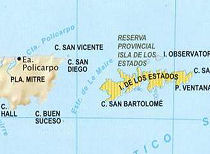 superioriteit van Juan’s oprechte warme ziel. superioriteit van Juan’s oprechte warme ziel.
Zijn vriendschap voor Juan drukte zich uit in de respectvolle wijze waarop hij hem bejegende.
Juan, op zijn beurt, had besloten het zadeltuig voor zijn amigo te vervaardigen in liefdevolle handarbeid, moeizaam alle stukken leer eerst zorgvuldig kauwend, al de sprakeloze avonden die zij bijeen zaten en de kalebas met mate thee hun kiok was welke steeds van hand tot hand ging.
Bij iedere steek van de naald door het leer kwam het afscheid naderbij en zo uiteindelijk de dag van het vertrek. Er werden beloften gedaan en woorden gewisseld en toen Ricardo wegreed zonder omzien reed ook Juan weg van de plaats des onheils, zijn autospiegel stond hem enige achterwaartse blikken toe zonder de wet van de trots te overtreden.
|
|